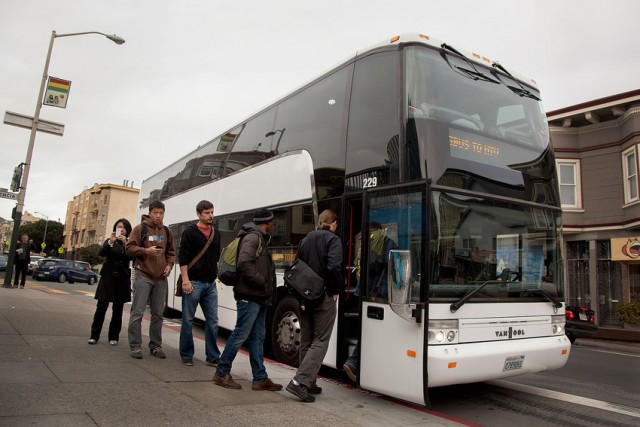At Tuesday’s meeting, several tech workers testified that while they value and use public transportation, it’s not a good option for them.
“I think if everyone who currently uses a shuttle got on a Muni bus or train in the morning, that would be a pretty big influx of people and that would negatively impact not only the shuttle users, but everybody else as well,” said Anna Tchetchetkine.
Another tech employee, Michael Chen, said having a shuttle as a transit option has allowed him to live without a car.
“By providing the shuttles, it means that many people who would otherwise drive or carpool to work are not taking individual cars … and reducing the burden on our overburdened public streets,” said Chen.
Doug Bloch with the Teamsters Union praised the SFMTA’s labor harmony requirement for shuttle companies, saying it’s helped unionize many drivers.
“Every day, 1,000 drivers get behind the wheels of these buses, and 500 have organized with the Teamsters and are now part of the middle class. And we can thank the MTA that has made that possible for these drivers,” Bloch said.
Critics, however, said the SFMTA needs to further study the impact shuttles have on Muni and affordable housing.
“This commuter shuttle program is largely an illegal corporate giveaway,” said Sue Vaughan of the Coalition for Fair, Legal and Environmental Transit. “It’s a giveaway of our public bus stops. We need those public bus stops so we can expand our own public transportation system.”
“We find that people are not happy, contrary to what we’ve been hearing … with a program that puts 400 corporate buses on their streets daily,” said Noe Valley resident Phoebe Cutler. “The recent iteration has managed to exacerbate the chaos by concentrating it on a few streets.”
SFMTA officials said they would work to address congestion concerns on 24th Street in Noe Valley. Some residents showed photos of the street clogged with shuttles.
SFMTA officials stressed the shuttle program is voluntary and that without it the situation on city streets would be much worse.
Participating companies will continue to pay for annual permits and allow the SFMTA access to GPS tracking data. Shuttle drivers will undergo safety training in order to comply with Vision Zero, the city’s program to end all traffic deaths by 2024.
Under the revised program, penalties for violations would increase from $250 to $500 and could reach $1,000 for repeated violations within a 12-month period.
Francesca Napolitan of the SFMTA, who manages the shuttle program, said the agency has collected more than $700,000 in shuttle fines since last April and is working on boosting enforcement by hiring more parking officers and targeting trouble spots. Overall, fines are down, a sign that enforcement is working, she said.
Josie Ahrens of Walk San Francisco, the city’s pedestrian advocacy organization, urged the SFMTA “to develop a single, clear way for the public to report dangerous behaviors by drivers.” In response, Napolitan said the agency was working with 311 on a reporting system.
Ahrens also encouraged the SFMTA to work with shuttle companies to integrate crash prevention technologies into their vehicles and make shuttle crash data transparent to the public.

